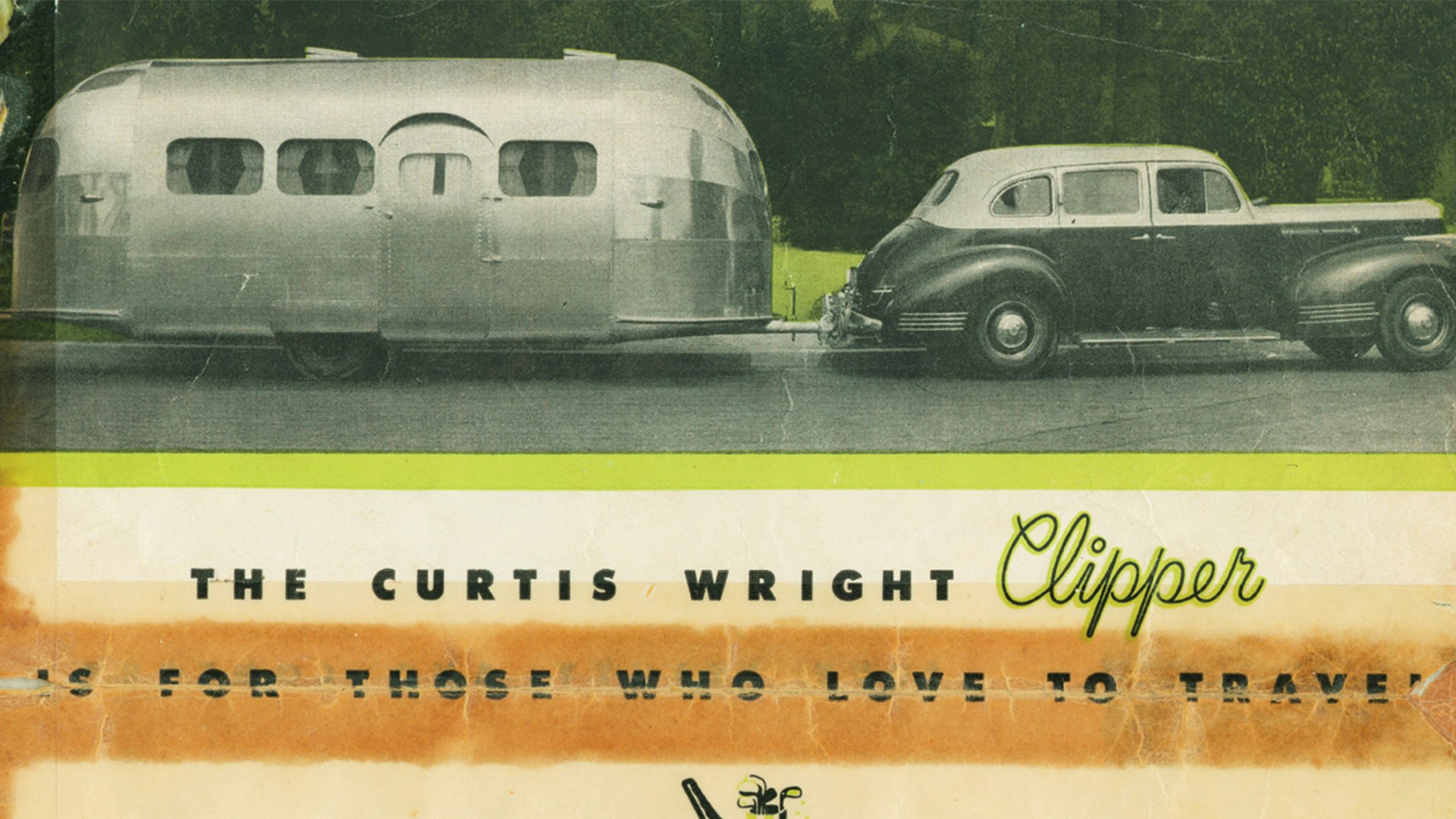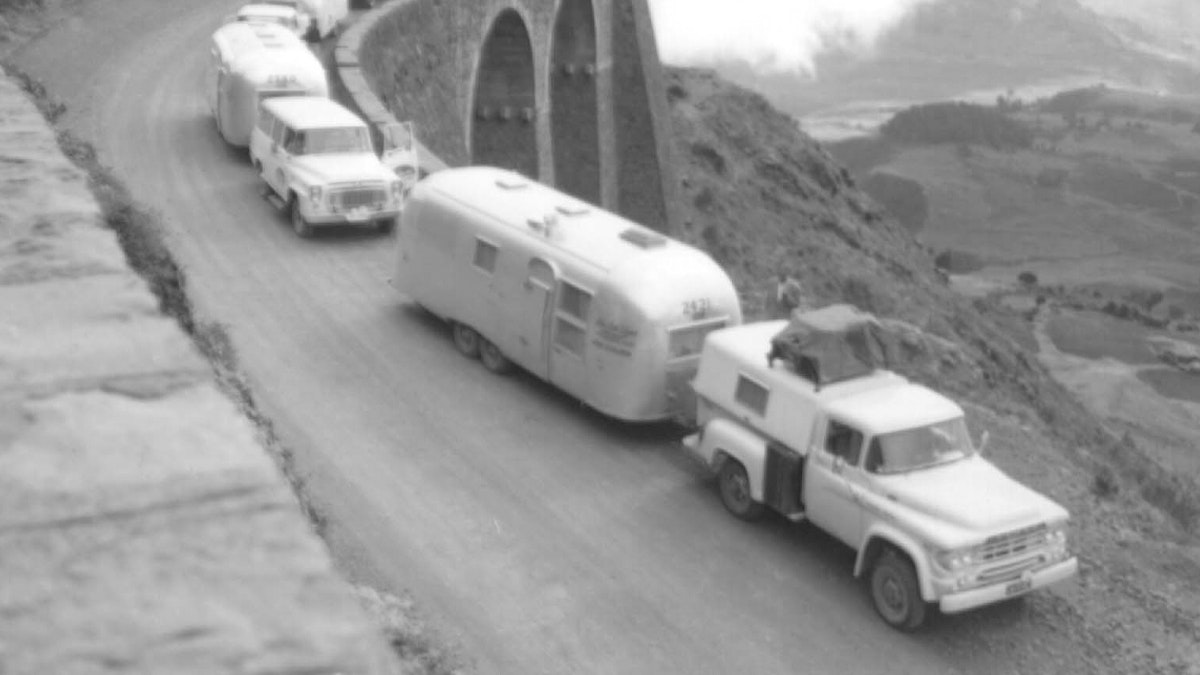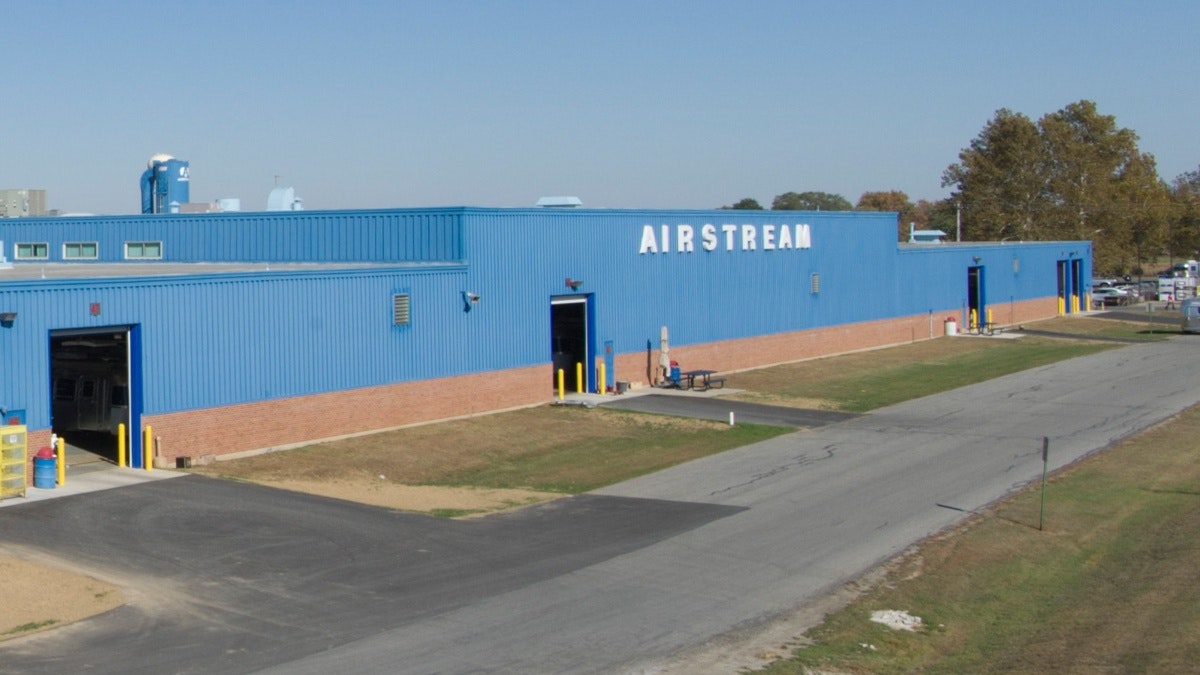Airstream founder Wally Byam was born on the Fourth of July, 1896, in Baker City – a boom town along the Oregon Trail, which his grandparents had traveled in a mule-drawn wagon on their journey out west. He grew up working hard with his uncle on a sheep farm, where he lived in a wooden wagon, towed by a donkey – much like his grandparents had. Inside the wagon he had a stove, food, water, and everything he needed, which would later inspire his first travel trailer.
Heritage
The 1920s

The original Airstreamer

"A pretty good business to get into"
After working to support himself through college and graduating from Stanford in 1921, Wally worked in journalism, advertising, and publishing. He and his first wife Marion went camping regularly, but she never enjoyed sleeping on the ground in a tent. So in 1929, Wally put together a tent contraption on top of a Model T chassis. It was mobile, but it wasn’t a lot of fun in the rain, and it was a chore to put together. He went back to the drawing board and replaced the tent with a teardrop-shaped permanent shelter – and added a stove and ice chest, too. It was a proper trailer and it caught the eye of so many other travelers that Wally decided it might be “a pretty good business to get into.” Good thing he did.
The 1930s

From hobby to business
After building his own travel trailer, soon Wally's neighbors started asking him to build trailers for them like the one in his front yard, and he obliged. Noise complaints quickly followed, so Wally rented a building and opened a small trailer factory in Culver City, California in 1931 – Airstream’s first factory. They soon relocated, but the Airstream dream was born.

Trailers boom – then bust
When Wally Byam opened the first Airstream factory in California, there were fewer than 50 trailer manufacturers registered for business. In the next five years, demand for the trailer lifestyle exploded and the industry followed suit – by 1937, there were around 400 manufacturers competing for customers. Unfortunately for many of those daring entrepreneurs, the Great Depression and World War II took a toll, and today, only Airstream remains.
The 1940s

The war years
When the United States entered World War II after the attack on Pearl Harbor, aluminum became hard to come by. In fact, the government ordered that travel trailers could only be made as part of the war effort, not for public recreation. Wally saw Airstreams as a mode of travel – not a substitute for a house – so he decided to close up shop. For the duration of the war, Wally and many Airstream crew members found employment in various aircraft factories in California. The experience they got from working on military planes would end up serving Airstream quite well at war’s end indeed.

The Curtis Wright Clipper
As World War II drew to a close, Wally Byam was working as a certified manufacturing engineer and production supervisor at Curtis Wright Industries. When the war ended in 1945, Wally persuaded the management at Curtis Wright Industries to let him manufacture a line of travel trailers called the Curtis Wright Clipper, similar to the Airstream Clipper in many ways, but improved with Wally’s new manufacturing know-how.

Battle-testing on the road
In 1947, Wally left Curtis Wright Industries and began manufacturing the Airstream Liner. The next year, Wally went to Europe with his friend Cornelius “Neil” Vanderbilt, Jr. to tour the war-ravaged land. Neil’s goal was to film postwar Europe for lecture tours, but Wally’s was all for Airstream. They traveled the continent in an Airstream trailer, and Wally wanted to road test the trailer to find weaknesses that needed fixing, as well as improvements that could be made. This may not have been the plan at the time, but the trip would end up as a precursor to the Airstream caravans that would follow in later years.
The 1950s

The first Airstream caravan
In 1951, Wally Byam decided to travel with a group of friends from Texas to Nicaragua. When a magazine picked up the story, he invited other adventurous Airstreamers to join in the Los Angeles Times. He expected about 35 trailers to show up; he got 63. The first caravan wasn’t the smooth ride today’s Airstreamers are used to – nearly impassable roads and bad weather led to equipment failures, and many travelers dropped out early. Only 14 completed the trip, and Wally said he’d never do it again. Luckily for all of us, that vow lasted only a year.

Moving east
By 1952, Airstream had outgrown its Los Angeles plant and desperately needed to expand. Rather than staying on the West Coast, Wally traveled east to scout locations across the Midwest. He spent a summer looking in Indiana, Illinois, and Ohio before finding a factory for sale in Jackson Center, Ohio. With Neil Vanderbilt on the board and Airstream’s obvious success, funding was easy to find, and soon Wally had his ideal second location locked down. And it turned out to be a great choice – more than sixty-five years later, Airstream is still making trailers in Jackson Center.

Necessity is the mother of invention
When you’re constantly trying to push the envelope on the road, you need to innovate. As people took Airstream trailers to new and more challenging locales, they needed more. And Wally Byam fostered that, urging people to create what they needed when it didn’t already exist. In 1954, he convinced Mark Bowen of Bowen Water Heater Co. to develop the first hot water system ever in a trailer. The 1958 Airstream International was developed as the first-ever “self-contained” travel trailer – one with full freedom from external trailer hookups, like outside sources of power. With new capabilities, Airstreams could go farther for longer than ever before.
The 1960s

A legend passes
After battling cancer with his trademark tenacity, Wally Byam passed away on July 22, 1962. He left behind an Airstream company at its peak, working to meet the demand that Wally’s dreams and hard work had created for travel, adventure, and experiencing the world first-hand. As for a successor, Art Costello was formerly the President of Airstream Trailers, Inc. of California and Andy Charles was formerly the President of Airstream Trailers, Inc. of Ohio. After Art became Airstream's President, Andy was voted Chairman of Airstream's board.

Refining the shape
In 1969, the Airstream trailer had its first major redesign in over 30 years, with an internal facelift as well as exterior and structural changes. The end result was an Airstream with rounder edges that further enhanced the distinctive “silver bullet” shape. It even added a foot of length and four inches of width. It was a big step on the path from Wally’s first trailer to the one you see on the road today.

Out of this world
When humans first visited the moon in 1969, it was feared that the astronauts who walked on its surface might bring back disease or other maladies with them. NASA took every precaution, and it was decided that the Apollo 11 trio would be quarantined upon their safe return. Airstream was tasked with constructing a “mobile quarantine facility” that could be taken to the USS Hornet, which would greet Neil Armstrong, Buzz Aldrin, and Michael Collins. There’s even a famous photo of President Richard Nixon speaking to the trio from outside.
The 1970s

Spreading out
For the first four decades or so of Airstream’s life, we were exclusively a travel trailer company – Wally Byam had thought several times about diversifying and producing a motorhome, but each time decided against it. In 1974 that all changed. With leadership wanting to avoid being entirely dependent on one product for revenue, the Argosy motorhome debuted. Sales were modest, and the Argosy line would be discontinued in 1979. But the will to innovate would live on in later models like the Classic motorhome, the Land Yacht motorhome, and the Interstate touring coach.

Coming back together
In the late 1950s, Airstream purchased four acres in Jackson Center, Ohio, near our Midwest factory. In 1971 a seed was planted there, and from it grew the world’s most modern trailer manufacturing facility – 150,000 square feet in total. As a recession and the Middle East gas crisis hit American drivers hard in the late 1970s, it did the same to Airstream. With the expansion of the Jackson Center facility and a need to consolidate, Airstream finally made the move east complete. The California plant was closed in 1978, and all manufacturing and executive operations would move to the Ohio complex – where they remain today.
The 1980s

Venturing to new lands
The Wally Byam Caravan Club International has been around since the 1950s, and in the 1970s and 80s they held numerous rallies and caravans around the world. In 1985, a caravan of Airstreamers made Airstream history by traveling through China for the very first time.

Under new management
Airstream leadership had been in flux for years after the passing of Wally Byam, with control of the company changing hands several times in the next few decades. In 1980, stability came once again. Wade Thompson and Peter Orthwein, owners of Hi-Lo Trailers, saw the market starting to pick up and moved to form a new company, Thor Industries, and acquire Airstream. And that association continues to this day, over thirty years later.

Becoming an icon
The design and beauty of the Airstream trailer have gained it many admirers, and after decades of touring the roads and campsites of America (and the world), it’s gone from being an oddity to a true American icon. One example? In 1987, Money magazine chose the Airstream travel trailer as one of “99 Things That, Yes, Americans Make Best” alongside titans of American industry like Coca-Cola and Heinz ketchup.
The 1990s

In with the old
With the quality and longevity of Airstream and our trailers, often an individual trailer can still find great use for decades or even longer. In the late 80s and early 1990s, interest in older Airstreams began to grow, including restoring them to their original glory and renovating them to mix vintage and modern styles. To meet this demand, in 1993 a new chapter within the Wally Byam Caravan Club International was formed, appropriately named the Vintage Airstream Club. To join, owners have to have a trailer that’s at least 25 years old.

In with the new
In addition to honoring Airstream’s rich history, the 1990s saw a rededication to newer generations of travelers. To attract younger buyers, a new version of the 1950s Safari travel trailer was introduced. With a cost 20 percent less than its contemporaries, it was easier to afford while maintaining the quality Airstream demands. And because it weighed 20 percent less than a traditional trailer, it could be towed by lighter vehicles. It was a hit, and quickly about half the Airstreams being sold were Safaris.

The old becomes new
As for the new trailers rolling off the line, it had been since 1969 that any major design change had been made. In 1994, Airstream undertook its first major redesign in almost 30 years, with subtle changes to the profile and structure that resulted in a larger, more comfortable travel trailer while maintaining performance – and the iconic Airstream shape. And by 1996, Airstream added about five-and-a-half inches in width to the entire travel trailer line along with an overhaul of the interior design.
The 2000s

A new take on motorized
Though Airstream had experimented with motorhomes in the past, the launch of the Interstate Touring Coach in 2004 was the beginning of a truly inspired collaboration with Mercedes-Benz®. The Class B RVs were built on Sprinter van chassis with capacity to seat several people, yet still feel like a motorhome with a full kitchen and bath. Those first Interstate coaches were the basis for today’s touring coach lineup.

A half-century of community
In 2005, the Wally Byam Caravan Club International celebrated its 50th anniversary. From the first Central American caravan Wally led to his adventures across Europe with Neil Vanderbilt, from tours of the United States to trips to Africa and China, the WBCCI has spent half a century helping Airstreamers meet each other, form lasting bonds and memories, and travel the world safely and enjoyably.

Seventy-five years on the road
The next year, Airstream itself had its 75th birthday. The silver bullet design has stood the test of time, and so has the riveted-aluminum construction. The company’s longevity is reflected in the products we build – in 2006, 65% of the Airstreams that had been built since Wally Byam’s first trailer were still on the road. In fact, some of those aged warriors included some of the ones built from the five-dollar plans Wally sold before the first factory was even open.
The 2010s

Changing as travelers do
While today’s travelers are inspired by the same kind of wanderlust and curiosity as our founder Wally Byam was almost 100 years ago, the way they want to travel continues to change. And it’s our job to keep our finger on the pulse of those changes. In fact, in response to a growing number of people who want all the comforts of home without towing a large trailer, two of our newest additions to the travel trailer family are smaller and nimbler than ever: the Basecamp (a revival of the original) and the Nest.

Control from your phone
Today, we can control everything with our smart phones and devices. And we expect our RV experience to be no different. In 2018, Airstream made that expectation a reality with Smart Control Technology. 2019 Classic Travel Trailer models come with the technology, which pairs with an app to let you monitor and adjust many of the features inside and outside the trailer, including the lights, awning, tanks, battery, and more. Read more about Smart Control here.

A new headquarters
In 2018, we broke ground on our first new plant in more than 50 years. Our new 750,000-square-foot headquarters will stay right here in Jackson Center, Ohio. The new facilities will give us more space, more tools, and more storage, prioritizing the quality and craftsmanship we’re known for. Plus, it’ll create jobs and boost the economy in a community we know and love. Read more about the new headquarters here.




























































































